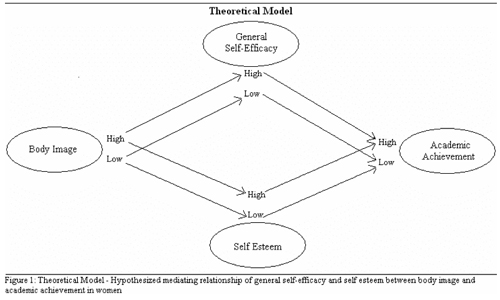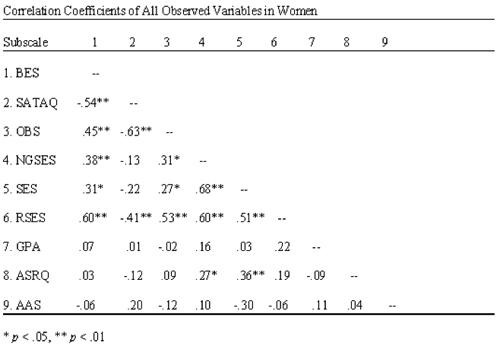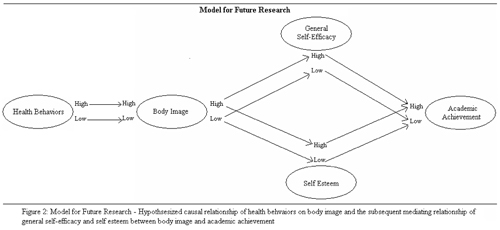|
Research
Body image concerns: Who cares? Maybe you should
Why body image matters to recreational sports participants and administrators
 Body image includes descriptive and evaluative beliefs about one’s appearance (Slade, 1994). Assessments made about one’s body are highly influenced by cognitive, affective, attitudinal, and other variables. These self-assessments are crucial to other aspects of life. Body image includes descriptive and evaluative beliefs about one’s appearance (Slade, 1994). Assessments made about one’s body are highly influenced by cognitive, affective, attitudinal, and other variables. These self-assessments are crucial to other aspects of life.
Tyler L. Fortman, GAA Recreational Sports at The Ohio State University, conducted a research project to examine the relationship between body image, self esteem, self-efficacy, and academic achievement. A correlational design examined Fortman’s hypothesis that poor body image lowers self-assessment (self-efficacy and self esteem) evaluations, in turn negatively affecting academic achievement in women, as shown in previous literature. Ninety-two male and female first-year college students completed three measures of body image, two general self-efficacy scales, a self esteem scale, and three measures of academic achievement. Because body image varies widely based on gender, males’ body images were not hypothesized to affect their self-assessments.

Results were analyzed using structural equation modeling and an examination of the correlations between variables. In women, measured variables of body image were associated with measured variables of both self-assessments—general self-efficacy and self esteem. Furthermore, substantial relationships were found between measures of body image, self-efficacy, self esteem and academic achievement.
Correlations show support for the hypothesis and estimates of the structural equation model that, in women, body image is strongly associated with both general self-efficacy and self esteem. The structural equation model for women supported the hypothesis that body image in women predicts self-assessments. Thus, as hypothesized, high body image in women predicts high general self-efficacy. Moderate, yet significant (p < .05) correlations between self-efficacy and academic achievement measures were also found.

BES: Body Esteem Scale
SATAQ: Sociocultural Attitudes Toward Appearance Questionnaire
OBS: Objectified Body Consciousness Scale
NGSES: New General Self-Efficacy Scale
SES: Self-Efficacy Scale
RSES: Rosenberg Self Esteem Scale
GPA: Grade Point Average
ASRQ: Academic Self-Regulation Questionnaire
AAS: Academic Achievement Scale
The finding that body image affects general self-efficacy has specific implications. By definition, general self-efficacy affects one’s belief in his or her capability in a general domain. This means that no matter what activity a person is engaged in, he or she will feel less capable if he or she has a lower general self-efficacy. Thus, lower general self-efficacy will likely result in poorer performance in all areas. The effects of body image on general self-efficacy cannot be overlooked.
Poor body image also results in lower self esteem in women. Women with lower self esteem, by definition, have greater depression and less feelings of self-worth. The importance of this finding is significant. Body image is a growing target for marketers. As a result of marketing and the media, a growing number of both women and men have distorted body images. This study showed that distorted body image affects general self-efficacy and self esteem.
A study conducted by Lowery et al. (2005) further related body image to self esteem and examined their relationship with health-related behaviors. Survey data from 433 first-year college students on body image, self esteem, and health behaviors showed similar results to the study conducted by Fortman. Low body image measures were, indeed, inversely correlated with high self esteem. Lowery then investigated the relationship between body image and health behaviors and found that women and men who regularly exercised had higher self-esteem and body images than women and men who did not regularly exercise (Lowery et al., 2005). As the results of Fortman (2006) would predict, self esteem was only affected by positive health behavior when the mediator, body image, was considered. Thus, body image is the crucial link between positive health behaviors and improving self esteem.
Lowery et al. (2005) analysis separating the genders had opposite conclusions. Researchers reported that no body image or self-esteem differences were found for women who exercised regularly when compared to women who did not exercise regularly. Similarly, men who exercised regularly and those that did not had similar body images.
These contradictory findings may be seen for a variety of reasons. First, Lowery et al. (2005) administered surveys during class times. This methodology lends itself to the biases of social influence. As we know, physical fitness among college students is socially expected. Thus, subjects may have been inclined to lie about their exercise behavior. Additionally, regular exercise was not defined. Further research should compare a control group, surveyed in a common campus location, to an exercise group, surveyed at the entrance of a physical recreation center using Likert scales to define exercise frequency, intensity, and duration.
It is also important to be mindful of the difference between statistically significant and practically significant results. Statistical significance demonstrates that the control and treatment group differ by an amount that is not likely based on chance alone. On the other hand, practical significance is demonstrated when the difference between the two groups is large enough that the implementation of the treatment is worthwhile to achieve the given difference. Lowery et al. (2005) demonstrated statistical significance between exercisers’ and non-exercisers’ body image and self esteem. However, the statistical significance of the results was easily reversed when men and women were separated; thus showing a lack of practical significance. Future research must intend to document practically significant differences between exercisers and non-exercisers such that conclusions are consistent in the analysis of aggregate data and analysis of each gender.
The weaknesses of Lowery et al. (2005) must be considered before a clear relationship between body image, self-esteem and health related behaviors can be compared. It is clear that body image is highly related to self-esteem and academic achievement (Fortman, 2006). Relating these findings to exercise is crucial. Future college recreational sports research must investigate this area using a rigorous methodology and hypothesizing that exercise behaviors are related to body image such that self-assessments and academic achievement are improved.

References
Fortman, T. L. (2006). The effects of body image on self-efficacy, self esteem, and academic achievement. Unpublished manuscript, The Ohio State University, Columbus, OH.
Lowery, S. E., Robinson-Kurpius, S. E., Befort, C., Blanks, E. H., Sollenberger, S., Nicpon, M.F. et al. (2005). Body image, self-esteem, and health-related behaviors among male and female first year college students. Journal of College Student Development, 46(6), 612-623.
Slade, D. (1994). What is body image? Behaviour Research and Therapy, 32, 497-502.
|

